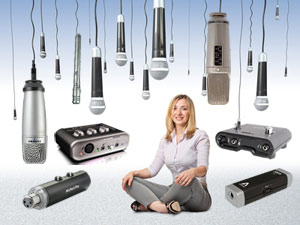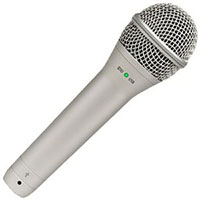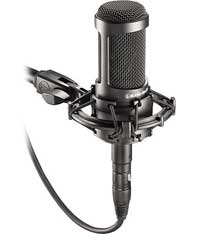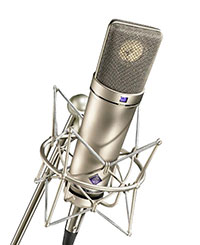Improve The Quality Of The Audio You Record At Home – Tip 5

This is week 5 in our series of videos and posts giving you tips for improving the quality of the audio you record in your home studio.
All the tips so far (if you’ve missed them, you can start with week one here: Improve The Quality Of The Audio You Record At Home – Tip 1) have shown you quick, easy ways to improve your audio without having to to buy or build anything. But they also had something else in common.
They all work to make your audio sound more professional no matter what kind of microphone you are using – cheap or expensive.
The Microphone Is Not The Most Important Thing
It was quite intentional to NOT make “buying an expensive microphone” the first tip in a series about how to record better audio. Usually, it’s the the first thing people think they need to do in order to record more professional audio. But that simply is not the case. I think it belongs at about number 5 or 6 on the list. If you’ve been trying out all the tips in this series, you’ll know first-hand how to massively improve your audio using the exact same mic you started with, no matter how cheap or expensive it is. Technique — how you use your gear — is by far the most important element.
Better Audio With A Better Mic
Even though I don’t think it’s the most important thing, it doesn’t mean you can’t improve your audio quality by using a different/better microphone. And this week’s tip is that no matter what mic you currently have, you can probably upgrade to the next level for much less money than you thought.
For example, if you change from using a $5 computer mic to a $25 USB headset, it’s going to sound better. Cost of upgrade – $20. If you start with the USB headset and switch to using a $49 USB handheld mic like the Samson Q2U, the quality will skyrocket dramatically.
Then moving from that to a $65 large-diaphragm USB mic like the Samson C01U, the quality jumps again. Make the switch to an audio interface with a standard large-diaphragm condenser microphone for a couple hundred dollars and the quality goes up again, and so on.
Generally speaking, for vocals – a large-diaphragm condenser mic like this Audio-Technica AT2035 – will work best for vocals.
HOWEVER, there are two other types of microphone that sound terrific on vocals. Believe it or not, shotgun mics – typically used for video (such as the Sennheiser MKH416), sound great as close-up vocal mics.
And though you would typically stay away from cheap dynamic microphones for vocal recording, certain TYPES of dynamics – called broadcast dynamics – can sound fantastic – such as the Electro-Voice RE 20 or the Shure SM7. In fact, since those mics are dynamic mics AND they have a cardioid pickup pattern, you get a double-dose of audio quality improvement.
The cardioid pattern helps reject noise from most parts of a room, AND the fact that a dynamic mic is less sensitive to ambient noise overall, you get a lot less noise (air conditioning hum, computer drives spinning, etc) than with a large diaphragm condenser.
There are too many mics to mention, and we can’t try them all. So here is my advice if you do not already have a really good microphone. If you are not currently using one, try a large USB mic like the Samson C01U.
The next step to improving even more – when you are ready to invest a few hundred dollars – is to get yourself an audio interface such as this Focusrite Scarlett 2i2 or Scarlett Solo, which plug into your computer via USB. Then get a standard (meaning NOT USB) large-diaphragm condenser mic such as the Audio-Technica AT2035 and plug it into your interface. That kind of set-up — a large diaphragm condenser mic plugged into an audio interface device — is what even the highest-end professional studios use.
Over time, and as your budget allows, you’ll want to try different mics. Here’s what’s on my wish-list right now. I’m saving for a Sennheiser MKH 416 shotgun mic for voice-over work.
And though I drool over the thought of having one, it will be some time before I’ll be able to afford – or at least convince my wife that we can afford – a Neumann U-87, which currently would set you back about $3,600. Well, maybe some day.
So this week’s tip is that regardless of what microphone you are currently using, you can almost certainly upgrade for a lot less money than you thought. I also told you what kind of mics usually work best for vocals, and I mentioned a few specific mics you can try out. Don’t forget to tune in next week for yet another tip for dramatically improving the quality of the audio you record in your home studio. See you then!




Hi Ken,
Thank you again for another amazing audio tip. I look forward to them. I always learn something great from each one. Keep them coming. 🙂
So glad you’re liking these, Danielle! You’re very welcome:).
Ken
Hi Ken,
Thanks for these tips. Most of the recordings I do are for my web site http://www.preciousmetalsinvesting.com. Usually I will be videoing two people so the distance to the mic is one to two feet since you really don’t want the mic in the picture. One of the things you said on your wish list is is that shotgun mic make a surprising good choice for voice overs. Is this because the design of the mic, which is usually thought of as being used for recording sound sources at a distance, in effect brings the sound source closer similar to your tip #1 “bring the mic closer” or is the Sennheiser just a superior mic? What do you think of the Rode mics? The Rode NTG-2 has the advantage of being dual powered so you can use it with XLR inputs and with a low cost adapter the 1/8″ input used on most of today’s consumer and pro-sumer camcorders and recorders. Thanks again for your help.
All the best,
Ted
Hi Ted. From a couple of feet away, not only will a shotgun mic work well (up high and to the side pointing down toward their mic, but also a small-diaphragm condenser mic like the Shure SM81 (which does NOT work well as a close-up VO mic, BTW – way to sensitive). If you haven’t seen it, you should watch my video on getting great audio on a talking-head video here: https://www.homebrewaudio.com/how-to-get-good-audio-on-your-videos/
About shotgun mics for VO – it isn’t because they are very sensitive (which is why the SM81 doesn’t work well for that), but rather that the capsule (on the Sennheiser 416 at least) is toward the bottom of the mic rather than at the top. So beside the fact that it just sounds awesome to start with, it won’t give you quite as many problems with p-pops as an LDC. And even though your mouth is -by definition – further from the capsule (because it’s toward the bottom), the hyper-cardioid pattern is more forgiving in terms of picking up more room sound the further away it is from your mouth. Make sense?
Hope that helps!
Ken
I’ve seen all these tips now, and they’re great! I’m going to recommend them in the Podcasters’ Support Group on Facebook
Thanks so much, Andy!